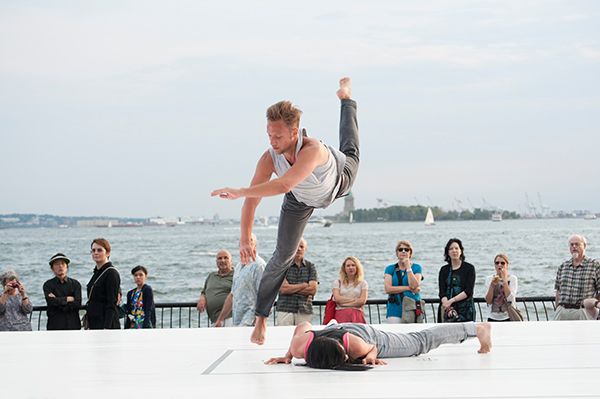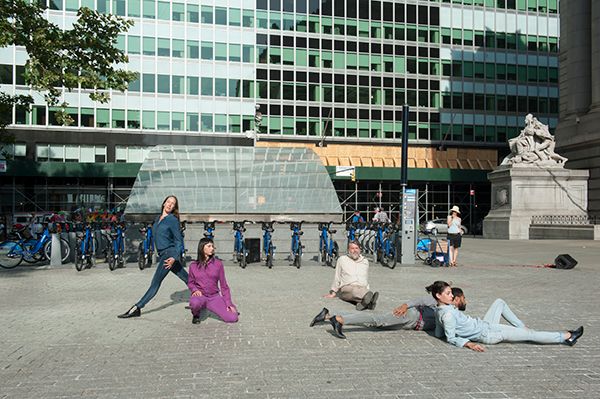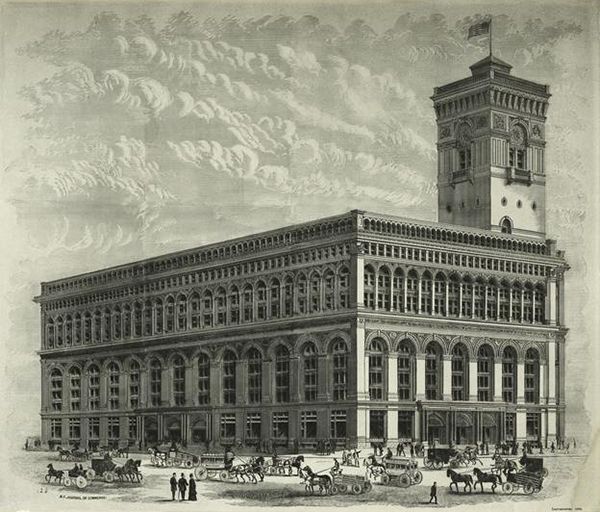|
DOWNTOWN
POST NYC
News and Events
in Lower Manhattan
|
|
|
|
Volume 1, No. 108 Aug. 22, 2014
|
Quote of the day:
"If it's in the book, it's a risk. You can't say 'never.'" - A Southbridge Towers shareholder explaining why documents describing the offering plan to privatize the subsidized Mitchell-Lama co-op had to be revised after an attorney said at a public shareholders' meeting that there was no risk.
* Angst and optimism at the Downtown Dance Festival
* Bits & Bytes: Southbridge Towers co-op offering plan hits snag; More Woolworth floor plans * Downtown history: George Post's lost Produce Exchange and its Seaport survivor * Calendar
Dancers from Tangaj Dance of Bucharest, Romania at the Downtown Dance Festival.
Aug. 21, 2014. (Photo: Terese Loeb Kreuzer)
|
|
|
|

|
ANGST AND OPTIMISM AT THE DOWNTOWN DANCE FESTIVAL | |
The Battery Dance Company performing a dance choreographed by Theo Ndindwa of Cape Town, South Africa. (Photos: Terese Loeb Kreuzer)
|
Some of the dancers at the recently concluded Downtown Dance Festival in Battery Park City came from far-flung parts of the world - India, Spain, Romania and South Africa. But many of the people in the audience were locals who returned to the festival night after night. "You're culture vultures," Jonathan Hollander, the artistic director of the festival, teased. He founded the festival 33 years ago on Stone Street in the Financial District. In previous years, the dancers performed on streets, in plazas and in historic Battery Park. But this year, because of construction and other issues, none of those places was available. The Battery Park City Authority came to the rescue, hosting the festival in Wagner Park from Aug. 17 to Aug. 21. With the Hudson River and the Statue of Liberty in the background, the setting could not have been more appropriate. Though certain dancers and dances stood out, the festival as a whole had its own gestalt. It had to do with liberty and its absence. There was a clear difference in sensibility between the work of the American dance companies and that of the Europeans. The American work tended to be optimistic and upbeat. The Europeans expressed a familiarity with hardship and brutality that most Americans have never known. The festival opened on Aug. 17 with a performance by the spirited Vanaver Caravan, honoring the late Pete Seeger and his lifetime commitment to music and social justice. The youthful company danced to music from the 1960s ("Turn, Turn, Turn," "To Everything There is a Season," "Where Have All the Flowers Gone?" and the like) and to music from the 1930s that also expressed idealism and protest. Even though a song might grow sad, there was still the promise of a better future.  | |
Entomo EA&AE from Spain.
|
Not so in the dancing of Entomo EA&AE, a duo from Spain, who performed on the second night of the festival and again on the last night. Alvaro Esteban and Elias Aguirre, dressed in dark colors, were human at times in their actions and sometimes behaved like insects crawling through the mud. Spain has had a tragic history. The dictator Francisco Franco, who enforced his will with the dreaded Guardia Civil, died just 39 years ago. The bloody Spanish Civil War is only three generations in the past, and well within living memory. Currently, Spain is experiencing economic hardship. It is not surprising that these dancers saw little hope for the human race.  | |
Tangaj Dance from Romania.
|
The dance that the Romanian company, Tangaj Dance, presented on the last night of the festival was even more harsh. It depicted the conformity imposed by dictatorship and the brutality it engendered. This dance included a sexual encounter in which an innocent, young woman was all but raped, with the collusion of her "friends." The Romanian dictator, Nicolae Ceaușescu, was executed in 1989 after inflicting years of cruelty and hardship on the Romanian people. Some of the dancers in Tangaj Dance were undoubtedly born during his regime or shortly thereafter. The company was formed only last year and came to the festival barefooted, with costumes that consisted of t-shirts, shorts, hoodies, and pants - perhaps reflecting a slim budget - but nothing more was needed. The dancers turned in a gut-wrenching performance as they grappled with wounds that have yet to heal. The last dance in the festival was a still unnamed piece performed by Jonathan Hollander's Battery Dance Company in collaboration with Theo Ndindwa, a choreographer from Cape Town, South Africa. He co-founded and directs Arts Township International, an arts organization that works in the townships surrounding Cape Town. Though apartheid ended in the early 1990s, poverty and numerous social problems still exist in these formerly segregated communities. Ndindwa's dance was energetic and even exuberant. Repeatedly, the dancers leaped into air, soaring above the Statue of Liberty, visible in the background. Maybe despite the many problems of the past some of that American optimism has rubbed off. - Terese Loeb Kreuzer
For more photos of the Downtown Dance Festival, click here.
|

|
Bits & Bytes
SOUTHBRIDGE TOWERS CO-OP OFFERING PLAN HITS SNAG;
MORE WOOLWORTH CONDO PLANS; GREENMARKET; BMCC AUDITIONS
 | | Southbridge Towers. |
AG raps Southbridge Towers board on knuckles for co-op offering: It has been a long seven years for those shareholders of the Southbridge Towers co-op in the South Street Seaport neighborhood who would like to privatize the Mitchell-Lama complex. Attempts to create a valid offering plan have run into one problem after another. The latest is that the New York State Attorney General has objected to some of the things that were said at an information meeting for shareholders on July 29 about whether or not to convert the 1,651-unit, subsidized, Mitchell-Lama co-op to market rates. A vote on the issue has been scheduled for Sept. 28, 29 and 30. The Attorney General wants the Southbridge Towers board of directors to send out an amendment to the plan and to redact certain things from a DVD that was made of the meeting. "There were statements made about the possible risks," said a shareholder who attended the July 29 meeting, but who asked not to be named. "The attorney for the board would say, 'this will never happen.' But that wasn't the case. If it's in the book, it's a risk. You can't say 'never.'" In order for Southbridge Towers to leave the Mitchell-Lama program, two-thirds of the shareholders would have to approve the offering plan. "More and more people who were pro are now against because it's taken seven years to get to a vote," said the shareholder. "And now with all the rewrites of the book, people are starting to question what the hell's going on? I think the plan is going to be defeated." Corrections to statements made at the meeting are currently being mailed to shareholders. A corrected DVD of the meeting will be available soon. - Terese Loeb Kreuzer
"More Woolworth Building condo floor plans," The Real Deal, 8/22/14. "A $110 million penthouse in the sky may be a little steep for all but the wealthiest of buyers, but the Woolworth Tower Residences - being developed by Alchemy Properties on the upper floors of the Woolworth Building - have a lot more to offer," says The Real Deal. "Non-penthouse units in the building range in price from around $3.9 million to just under $29 million." For the complete article with photos, click here. Auditions for Writers in Performance at BMCC: A 12-week workshop at the Borough of Manhattan Community College offers a chance for people of all ages, ethnicities, styles and levels of experience to create an original theater piece and perform it at the Tribeca Performing Arts Center, 199 Chambers St. The workshop utilizes writing exercises, theater games, improvisation, movement and ensemble work by all participants. Auditions will be held by appointment only on Wednesday, Sept. 17 and Thursday, Sept. 18 from 5:30 p.m. to 8:30 p.m. The free workshop is directed by Mario Giacalone, the program director at BMCC Tribeca Performing Arts Center. He has taught acting in New York City for over 10 years and has directed both stage and film. To schedule an audition, contact him at Mgiacalone@bmcc.cuny.edu or call (212) 220-1459 on weekdays from Tuesday, Sept. 9 through Tuesday, Sept. 16. The performances will take place on Dec. 5 and Dec. 6. Tribeca Greenmarket: "The market is full of summer fruits," says Jay Ledoux, manager of the Tribeca Greenmarket. "Loads of heirlooms, peaches, peppers and more and more apples are showing up," he says. "Besides that the newest items I've taken note of have been the yellow donut peaches on Wednesdays (a new crop for Toigo Orchards) and the very popular radicchio at Lani's Farm on Saturdays." On Saturday, Aug 23, there will be a "Guess the Weight of the Melon" contest. Enter your guess for a chance to win a bag filled with greenmarket groceries. The Tribeca Greenmarket is located on Greenwich Street just north of Chambers Street and is open on Wednesdays and Saturdays from 8 a.m. to 3 p.m. For more information, click here.
|
Downtown history
GEORGE POST'S LOST PRODUCE EXCHANGE AND ITS SEAPORT SURVIVOR
 | |
As part of this year's River to River Festival, a dance by Maria Hassabi took place on the plaza at Bowling Green. Behind the dancers is the facade of 2 Broadway, designed by Emory Roth & Sons and erected in 1958-1959. (Photo: Terese Loeb Kreuzer)
|
Until 57 years ago, there was a lavish red brick building at 2 Broadway where a nondescript modern building now stands. No one would particularly notice what's there now. No one could have escaped noticing what preceded it.  | |
George B. Post's New York Produce Exchange
|
In an article in The New York Times entitled " A Brick Beauty Bites the Dust," (8/21/14), Christopher Gray tells what happened to architect George B. Post's masterpiece, the New York Produce Exchange. "The preservation movement may have been born when Penn Station was demolished in 1963, but it had a long period of gestation," says Gray. "Probably the most regretted structure to be taken down in the years before the station fell was George B. Post's colossal New York Produce Exchange, on the east side of Broadway, opposite Bowling Green. The giant 1884 brick hall was a monument to a time when wheat, oil and other commodities were central to the New York economy. Founded in 1861, the produce exchange served a nationwide network of produce and commodities dealers, and in 1881 they began building the most impressive exchange structure ever seen in Manhattan." Gray describes the building as "an arcaded fortress, as noble as anything in Florence, but in fiery red brick."  | |
The George B. Post building at 142 Beekman St.
(Photo: Terese Loeb Kreuzer)
|
The building survived until 1957, when it was demolished. "Nathan Silver, in his prescient 1967 book, 'Lost New York,' cut to the quick: 'The produce exchange, one of the best buildings in New York, was replaced after 1957 by one of the worst,'" says Gray. The attempted and actual destruction of New York City's past continues. In Lower Manhattan, the battle is being waged at the South Street Seaport, whose history as a port, trading center and marketplace goes back to the 17th century. Some of the buildings in the Seaport are more than 200 years old. Gray mentions in his article that Post covered his Produce Exchange "with inventive ornament, ships' prows at the corners, medallions of corn, cows and pigs elsewhere." Though the Produce Exchange is gone, a George B. Post building survives in the Seaport, and it, too, is covered with terracotta ornaments that reference its setting and its usage. At the corner of Beekman and Front Streets (No. 142 Beekman St.) is a handsome, red brick building decorated with fish motifs, cockleshells and starfish. The Seaport building dates from 1885 and was designed by Post for a descendent of the wealthy Schermerhorn family, who had built Schermerhorn Row on Fulton Street. Although the Produce Exchange is gone, at least something of Post's work at that time remains. "Graybeards who mourn the rich red brick of the produce exchange must be few in number by now," Gray observes. "At the time no one mobilized or picketed or raised any ruckus. But its passing became one of those subliminal 'aha' moments, a ready reference in the collective consciousness of New Yorkers that something valuable was slipping away, piece by piece."
- Terese Loeb Kreuzer
|

|
|
CALENDAR: Week of Aug. 18
 | |
The South Street Seaport Museum's lightship, Ambrose, welcomes visitors Wednesdays to Sundays on Pier 16. (Photo: Terese Loeb Kreuzer)
|
Ongoing: The Seaport Music Festival, produced and partially sponsored by The Howard Hughes Corp., continues on Friday nights through Aug. 29. Place: Fulton Street at Water Street. Time: 7 p.m. Free. For more information, click here.
Ongoing: Every Friday through Aug. 22, join a master drummer in Battery Park City's Wagner Park for Sunset Jams on the Hudson. Improvise on African, Caribbean and Latin rhythms. Drums provided, or bring your own. Place: Wagner Park. Time: 6:30 p.m. to 8 p.m. Free. For more information, click here.
Ongoing: An exhibit in the Lower Manhattan Cultural Council's arts center on Governors Island examines a pivotal time in Trisha Brown's early career as an artist and choreographer, as well as a particularly fertile moment for artistic production in New York City. With videos, photographs and installations, "Trisha Brown: Embodied Practice and Site-Specificity" highlights Brown's community of performers and artists, and the Lower Manhattan in which they lived and created. The exhibit shows Brown's investigation of simple movements such as walking or dressing, and the built environment, specifically through performances that took place on buildings inside and out, museum walls, parks, cobblestone streets, and other non-traditional performance spaces. The exhibition also bridges the transition in Brown's practice from site- and gallery-based work to proscenium stage work, for which she became well-known throughout the 1980s and beyond. Through Sept. 28. Times: Fridays and Sundays, noon to 5 p.m. Saturdays, 10 a.m. to 5 p.m. Free. For more information, click here.
Ongoing: "From Drills to Drums: Civil War Life on Governors Island." A program for kids, who will see first hand the lives of soldiers, civilians and prisoners on the island in the 19th century. No tickets or reservations required, but large school or day camp groups should call (212) 825-3045. Every Wednesday, Thursday and Friday. Place: Governors Island. Time: 10:20 a.m. Also at 11:20 a.m. Free. Ongoing: Hike Through History. The most comprehensive tour of Governors Island National Monument takes in nearly every highlight in the historic district. No tickets or reservations required. Visitors should be prepared to stand for a full 90 minutes and walk a distance of about 1.5 miles. Wednesdays to Sundays. Place: Governors Island. Meet at Soissons Dock. Time: 2 p.m. For more information, click here.
Ongoing: "A Town Known as Auschwitz" is an exhibit of photographs at the Museum of Jewish Heritage tracing the history of a town called "Oswiecim" in what is now Poland, where Jews and non-Jews lived side by side for centuries. When German forces occupied the town in September 1939, they renamed it "Auschwitz" and established a concentration and death camp there. More than 1 million people died at Auschwitz, including 90 percent of the town's Jews. The museum is at 36 Battery Place. For information the exhibit, click here. For information on the museum's hours and admission fees, click here.
Ongoing: Poets House in Battery Park City presents "A Painter and His Poets," the first major retrospective show of George Schneeman's collaborative paintings, collages, prints, and books, with portraits of his poet friends, spanning 40 years. "A sort of utopia in the visual field filled with pleasure, quickness and wit" is how Schneeman himself described his collaborative work with poets. Exhibition on view through Saturday, Sept. 20, during regular Poets House hours. Place: 10 River Terrace. Free. For information about Poets House, click here.
Ongoing: The South Street Seaport Museum's lightship Ambrose and its barque Peking welcome visitors Wednesdays to Sundays, 11 a.m. to 5 p.m. on Pier 16 (on the East River at Fulton Street). The Ambrose, launched in 1908, once guided large ships through the Ambrose Channel into New York harbor. Peking was launched in Hamburg, Germany in 1911, one of the last commercial sailing ships ever built. She was used to carry goods from Europe to South America and to return to Europe with nitrate. The museum's Visitors Services associates explain all of the fascinating details of the ships and their relevance to the history of New York as a port city. Cost: $12 (adults); $8 (students, 12-24 and seniors); $5 (children 2-11); under 2, free. To buy tickets, click here.
Ongoing: "Defining Lines: Maps from the 1700s and early 1800s" at the Fraunces Tavern Museum. Twenty-seven maps provide a perspective on the evolving nation's place in history. A map from 1804, never before exhibited, shows the U.S. postal routes. Place: 54 Pearl St. Time: Noon to 5 p.m., daily. Admission fees: $7; $4 (seniors, students with ID, children, 6 to 8 years old. Children, 5 and under, free. Active military with ID, free. For more information, click here.
Ongoing: The National Museum of the American Indian is open daily from 10 a.m. to 5 p.m., with free admission. It offers free films, docent-led tours of its exhibitions and tours of its premises, the Alexander Hamilton U.S. Custom House, designed by Cass Gilbert. The building, which was completed in 1907, is a National Historic Landmark and is listed on the National Register of Historic Places. One Bowling Green. Phone: (212) 514-3700. For the museum's calendar, click here.Upcoming on Sunday, Aug. 31: For the last 22 years, Labor Day Weekend has included the Great North River Tugboat Race and Competition in which some of the harbor's mightiest and smallest tugs and everything in between race each other down the Hudson River. The day's events also include a nose to nose competition (like arm wrestling except done with tugboats), a spinach-eating contest, a line toss competition and awards for such things as best mascot and best tattoo. A spectator boat accompanies the tugs as they parade up the river and then race back down to Pier 84 at West 84th Street. The spectator boat boards at 9 a.m. and leaves from Pier 83 at 9:30 a.m. Tickets: $25 (adults); $12 (kids). For more information or to buy tickets, click here.
|
|
|
Downtown Post NYC is emailed Mondays, Wednesdays and Fridays.
Editor: Terese Loeb Kreuzer
All articles and photographs in Downtown Post NYC are copyrighted and
may not be reprinted or republished without written permission.
© 2014
|
|
|
|
|